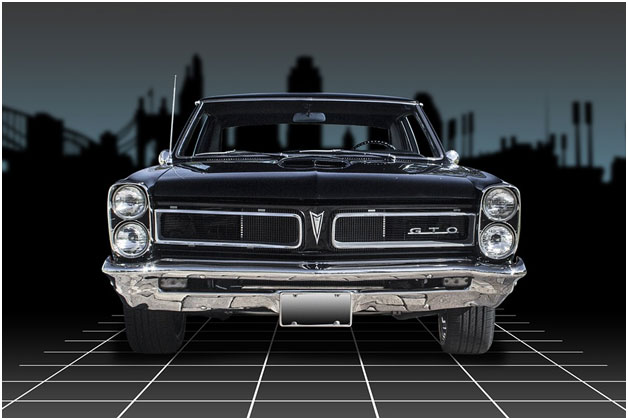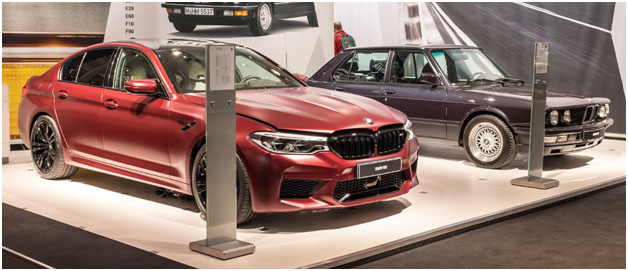
Image by Peter Benoit from Pixabay
Since gas-powered vehicles hit the roads, there has been an ongoing debate over the impact of our travels on the environment and climate. We’ll discuss the carbon footprint of classic cars and compare it to the environmental impact of technology within more modern vehicles. We’ll also offer recent data about the real impact of building a modern gas or electric car versus the driving habits of the classic car owner. Finally, we’ll talk about what modern emissions laws say about classic cars and what classic car owners should be mindful of in regard to emissions and the environment.
The Carbon Footprint of Classic Cars
The phrase carbon footprint is fairly new to many vocabularies, so let’s briefly explain what it means: A carbon footprint refers to the amount of carbon dioxide a person or family produces when living their daily life. While many people think the carbon footprint concept relates primarily to the use of transportation like cars and planes, water use and recycling are often included in your measurement. Like many modern fuel-burning vehicles, classic cars both produce carbon dioxide which is linked to climate change and global warming, and use fuel that is pumped out of the ground in manners that can cause pollution and environmental issues themselves.

By Matti Blume - Own work, CC BY-SA 4.0, via Wikimedia Commons
Comparing Classics to Modern vehicles
We can compare the carbon footprint of a classic car to a modern vehicle. To do this, let’s also carefully define what we consider a classic car. Some enthusiasts consider a vehicle over 25 years old to be a classic car, on the basis of some major changes made to automotive technology.
Changes in technology
Modern vehicles have many technological changes that enable them to burn less fuel. In some cases, a modern vehicle might also have a hybrid battery system or could be battery-powered with no gas at all. Within the car frame, gone are some of the heavier steels once used to make both the frame and exterior panels on a classic car. A modern vehicle uses some steel for the frame but has a mostly plastic exterior that weighs hundreds of pounds less. Finally, modern cars are smarter about fuel. The carburetor was replaced in the 1990s by either a battery or a modernized, computer-based fuel injector that decides the exact amount of fuel to send based on the driver’s inputs.
The result of these changes has a major impact on fuel mileage. Most classic cars were capable of reaching into the 20s for their highway miles per gallon. Many modern sedans can reach 40-plus miles per gallon on the highway. Battery-powered cars offer an “eMPG” rating which refers more to the number of miles per kilowatt hour but can offer a range of 250 miles or more per full charge.
Classic cars also didn’t have a catalytic converter as they weren’t required until 1975. The catalytic converter is a part of the exhaust system. The metals and filters within this device absorb some of the emissions produced by modern vehicles and produce steam that is less harmful. A modern catalytic converter can reduce the emissions of a vehicle by over 90%.
This argument is two-sided though: A modern vehicle takes much more energy to produce. The US Department of Energy estimates that building a modern car takes just over 31,000 BTUs of energy to produce, which is the equivalent of burning about 1,000 gallons of gasoline - and that’s before you ever turn the engine on. A battery-powered car like a Tesla tends to need around 250 gallons of gasoline burned just to make the battery. When purchased used, a classic car needs only transportation to your place and some maintenance and repairs as no new materials are used.
Older cars that use a carburetor or don’t have a catalytic converter have the potential to both use more gas and produce more emissions than a modern car.
The Arguments for Classic Cars and the Environment
While classic cars aren’t built with the latest technology designed to produce fewer carbon emissions and burn less gas, they offer your carbon footprint different ways to reduce your impact.
Less driving
The owner of a classic car tends to drive their vehicle less. Insurance companies that provide coverage for classic cars report that their drivers put on less than 2,500 miles per year, which is far less than the typical modern vehicle which is often on the road for more than 10,000 miles per year. Driving fewer miles means putting fewer emissions in the air, reducing the impact of driving around a vehicle with less technology to prevent carbon buildup.
Already assembled
Classic cars were made years ago. Buying a used car or a classic car is similar because you aren’t making auto manufacturers produce their own emissions when making a new car in the factory. As mentioned earlier, repeating those efforts by buying a new, modern car is less energy efficient.
In many ways, the life of a modern vehicle tends to be short. A study out of Japan indicates that most vehicles are built and scrapped within 13 years. Older, classic vehicles tended to be made to last longer - which is a major reason why they are still around and sought after.
Another study out of the United Kingdom indicates that it will take quite a while - 47 years, for a classic car to produce the emissions of building a modern car.
The Arguments Against Classic Cars and the Environment
Vehicles are a major source of carbon emissions, especially classic cars. Let’s also look at ways that classic cars are not environmentally friendly.
Owning two cars
While classic cars tend to be driven less, some owners of classic cars own a classic car and a modern car. While the modern car tends to get better gas mileage and puts out fewer emissions, it also had an environmental cost to produce.
Driving styles & maintenance
While it can take many years for a classic car to make a bigger environmental impact than the production of a new battery-powered Toyota, a modern car is still significantly better at handling modern traffic patterns. A modern vehicle - battery or gas-powered, tends to have a system built in to deactivate cylinders for highway driving and to turn off the engine while at a stoplight. Classic cars don’t have these features and can make long, fast drives as well as those traffic stops add more to their carbon footprint.
A classic car also needs to be well maintained in order to keep the vehicle from having a bigger environmental impact than it already has. To be fair, many classic owners know how to maintain their vehicles themselves.
Mileage
The studies we cited previously seem to assume that a classic car isn’t a daily driver. Less than 2,000 miles per year is more likely headed to a car show or on a pleasure cruise. Driving a classic car the same amount as a typical modern car erases much of the 47-year timeline in which a classic car would be more environmentally efficient.
The Role of the Government and Industry in Regulating Classic Cars and the Environment
While there are regulations and restrictions put forth by the Environmental Protection Agency regarding emissions and gas mileage ratings, these rules don’t apply to vehicles 21 years or older. The logic behind this is fairly simple: There aren’t that many vehicles that are 21 years or older, and those who drive a vehicle of a classic age do tend to drive less. People who do drive classic cars daily may not be able to afford a modern car. With all of this being said, there are probably fewer “classics” on the road than you think, with many of them kept as collector’s items or in museums.
Future regulations on classic cars are uncertain. Many modern Presidents and federal lawmakers, including Joe Biden, have their own classic cars and are unlikely to force modifications to old cars. Much of their legislation is focused on newly built vehicles. With that said, some local laws in places like California are taking aim at where high-emission vehicles can drive. California has also offered classic motors the ability to pay their way out of a smog check in what amounts to a carbon tax.
While previous legislation has been effective at forcing manufacturers to make more efficient vehicles, it’s unclear whether or not standards like those introduced in California will be effective because the laws don’t indicate how the state checks see if repairs towards emissions standards are made.
Conclusion
Knowing that a classic car could have less of an impact on the environment than building a whole new car, we also must recognize that a classic car also needs to be well taken care of and driven less than the average vehicle for its impact to be less significant. For example, taking a more modern vehicle on a road trip would be a more environmentally friendly choice if you have the option.
Additional Resources
- "Classic Cars Found to be Less Harmful to the Environment Than EVs: Study" - https://www.carscoops.com/2022/06/classic-cars-less-harmful-to-the-environment-than-evs-study-finds/
- "How Classic Cars Compare to Electric Vehicles in Environmental Impact" - https://www.footmanjames.co.uk/blog/classics-are-less-damaging-than-electric-vehicles
- "Are Classic Cars Good for the Environment?" - https://www.providentprotectionplus.com/are-classic-cars-good-for-the-environment/
- "Is Restoring a Classic Car Bad for the Environment?" - https://www.goldeagle.com/tips-tools/is-restoring-a-classic-car-bad-for-the-environment/
- "Classic Cars Emissions: Petrol, Diesel, Electric Vehicles Research" - https://www.express.co.uk/life-style/cars/1626431/classic-cars-emissions-petrol-diesel-electric-vehicles-research
- "EVs More Harmful to the Environment Than Classic Cars: Study" - https://www.driven.co.nz/news/study-finds-evs-are-more-harmful-to-the-environment-than-classic-cars/
- "How Green are Classic Cars?" - https://ccbank.co.uk/newsroom/how-green-are-classic-cars/
- "Classic Cars: Are They Greener than Modern Cars?" - https://www.motorious.com/articles/features-3/classic-cars-greener/
- "Classic Cars: Annual Emissions Equivalent to Drinking Three Cups of Coffee" - https://www.iaea-online.org/news/2022/10/average-classic-cars-annual-emissions-equivalent-to-drinking-thre
- "Classic Cars Less Damaging to Environment Than Modern Internal Combustion and Electric Vehicles: Automotive Sector Report" - https://automotiveindustrydigest.com/latest-fleet-news/classic-cars-less-damaging-to-environment-than-modern-internal-combustion-and-electric-vehicles-proves-automotive-sector-report/auto-news?
- "New Report Shows Classic Cars are Better for the Environment" - https://somersetapple.co.uk/news/new-report-shows-classics-cars-are-better-for-the-environment
- "Classic Cars Less Damaging to the Environment Than Previously Thought" - https://uk.news.yahoo.com/classic-cars-less-damaging-environment-094454069.html
